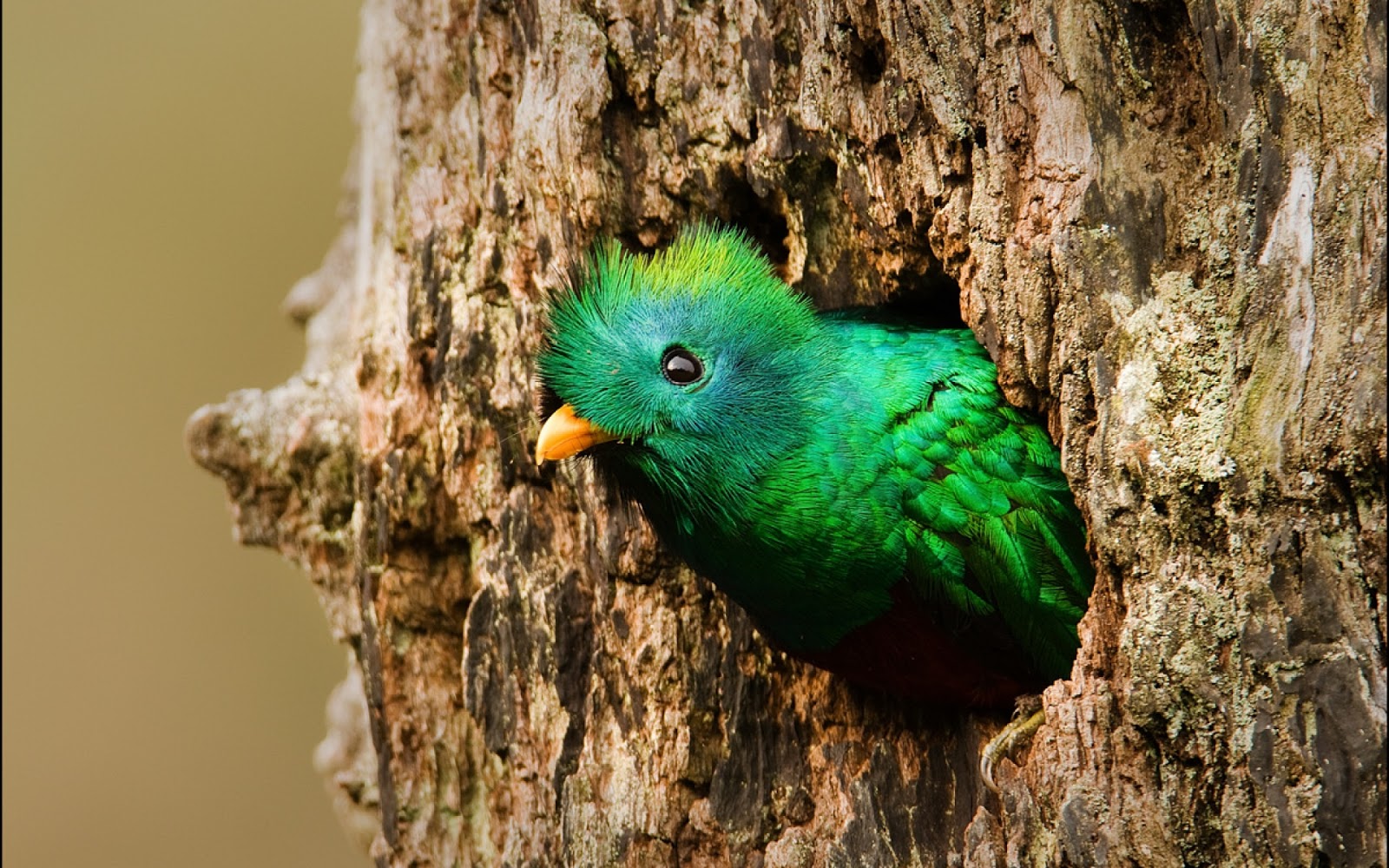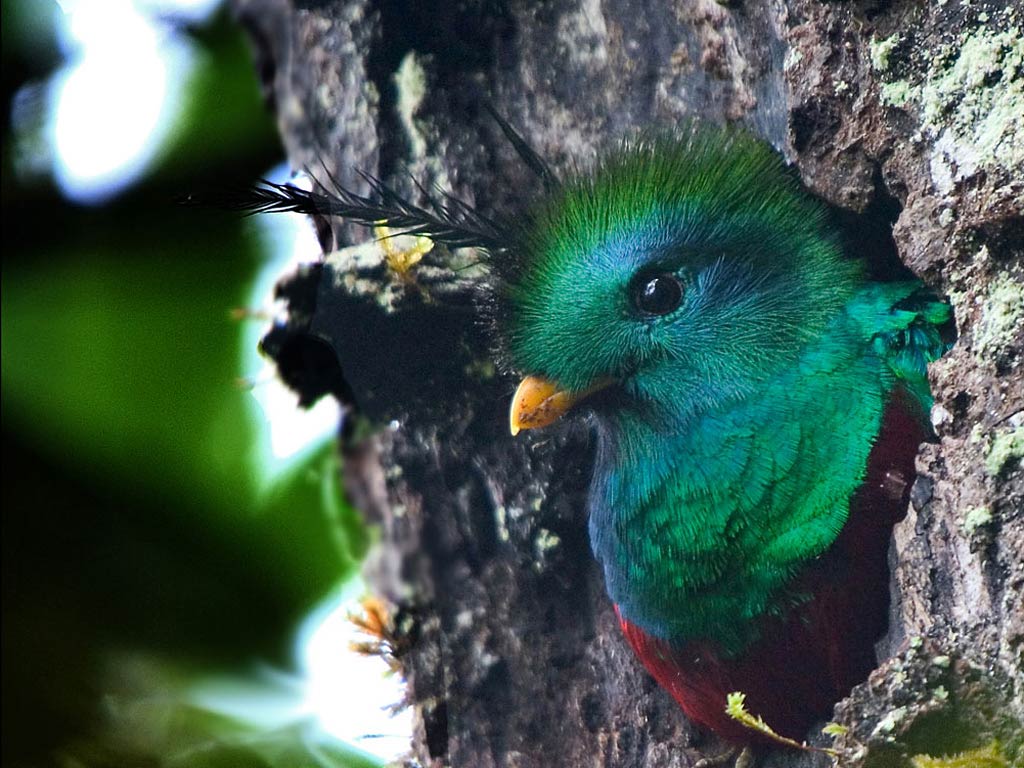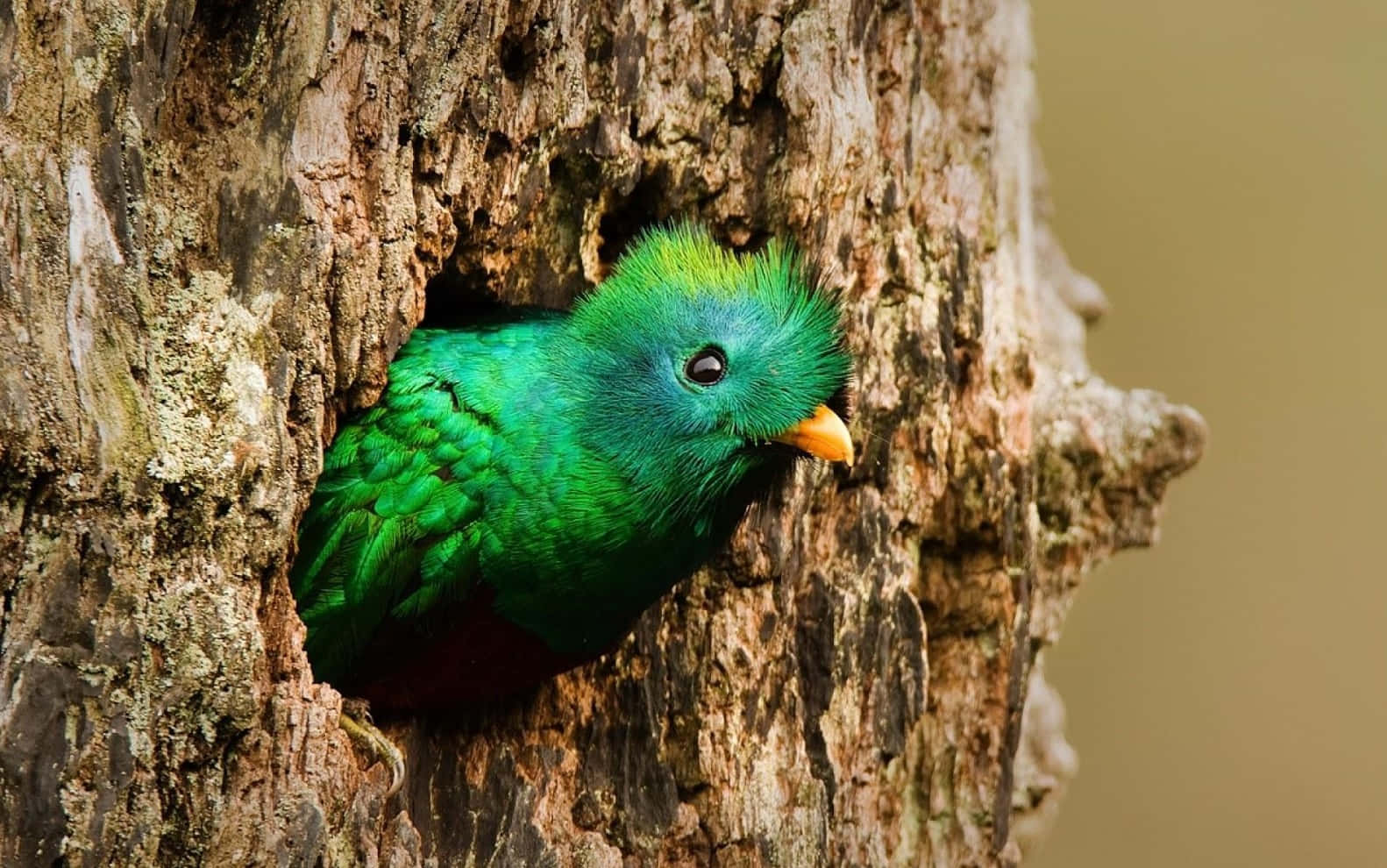The Quetzal Bird - A Glimpse Into Central America's Jewel
Have you ever stopped to think about creatures that truly capture the imagination, the kind that seem to leap right out of a vibrant dream? Well, the quetzal bird, particularly the resplendent quetzal, is one of those astonishing beings. This creature, a male resplendent quetzal, often seen perched on a tree branch, say, in Costa Rica, really embodies a certain kind of natural wonder. These are birds, you see, that just about everyone considers among the world's most beautiful, with their almost unbelievable colors.
These striking birds, you know, are found across a rather wide area, stretching from southern Mexico all the way down into Bolivia. They make their homes in the tropical forests of Central America, and their appearance is, frankly, quite unforgettable. With their long tail feathers and bodies painted in bright green, they really stand out. There are, actually, several kinds of these beautifully colored birds across the Americas that people call quetzals, but the one that most folks know best is, perhaps, the resplendent quetzal.
This article, then, is going to take a closer look at these amazing birds. We'll chat about their background, how they behave, their family life, and, too, some of the things that put them at risk. It's a chance, in a way, to learn about a creature that holds a special place, not just in nature, but in the hearts of many people, even lending its name to a country's money, which is quite something.
Table of Contents
- What Makes the Quetzal Bird So Striking?
- Where Do Quetzal Birds Call Home?
- The Quetzal Bird in Culture and History
- How Does the Quetzal Bird Live Its Life?
- What Challenges Do Quetzal Birds Face?
- Protecting the Quetzal Bird
What Makes the Quetzal Bird So Striking?
When you first lay eyes on a quetzal, particularly the resplendent quetzal, you are, basically, seeing something truly remarkable. These birds are, in some respects, a feast for the eyes, with their shimmering plumage that seems to shift between metallic blues, greens, and reds. It's an unforgettable sight, really. The male resplendent quetzal, especially, is known for its rather long tail feathers, which can be quite a feature, extending far beyond its body. These feathers are, typically, about 32 centimeters, or thirteen inches, in length, making them quite a statement.
The quetzal bird is a kind of trogon, a group of birds found in the warmer parts of Central and South America. They are, actually, somewhat larger than other birds in the trogon family, generally measuring over 32 centimeters themselves. While they might appear a bit squat or robust in their build, their most noticeable characteristic is, without a doubt, their coloration. It's a combination of brilliant blues, vivid greens, and rich reds that just about pops. This is, in a way, what makes them so special, a truly colorful bird with a distinctive crest that just adds to their unique look.
So, you know, when people talk about the quetzal, they are often thinking of this incredible display of color and those amazing tail feathers. It's what makes them, arguably, one of the most beautiful birds in the world, a creature that really stands out in its forest home. Their appearance is, quite frankly, a big part of their allure, drawing in birdwatchers and nature lovers alike who are keen to catch a glimpse of this feathered wonder. It’s a very distinctive bird, in many ways.
Where Do Quetzal Birds Call Home?
The quetzal bird makes its home in the mountainous, tropical forests of Central America, a place where it finds just the right conditions to thrive. You can, more or less, find these birds living in areas from southern Mexico all the way down through Central America. They are, actually, quite particular about their surroundings, preferring the cooler, misty conditions found at higher elevations within these forests. This habitat is, in a way, what allows them to flourish, providing them with the food and shelter they need to survive.
There are, you know, six different kinds of quetzal, and while they all share that stunning colorful look, their specific ranges might vary a little. However, they all tend to be found in these tropical forest settings, which are, in fact, quite important for their continued existence. The resplendent quetzal, for instance, is found in southern Mexico and Central America, a region known for its rich natural diversity. It's a member of the trogonidae family, and it’s very well known for its colorful plumage, as we've talked about.
Understanding where the quetzal bird lives is, therefore, pretty important when we think about how to protect them. Their habitat, these specific tropical forests, are, in some respects, quite sensitive environments. The presence of these birds, you know, often points to a healthy forest ecosystem. So, when we talk about the quetzal, we're also talking about the health of these precious natural places where they, quite literally, make their living.
The Quetzal Bird in Culture and History
The quetzal bird holds a truly special spot, not just in nature, but in the stories and beliefs of people, especially those from ancient times. For the ancient Maya and Aztec peoples, this bird was, actually, considered sacred. It was, in a way, a symbol of freedom and wealth, with its feathers being highly valued. They used these long, vibrant feathers in ceremonial headdresses and other important decorations, but they never, apparently, killed the bird to get them. They would, instead, gather the feathers after they had naturally fallen, which is pretty respectful, if you think about it.
This cultural importance, you know, continues even today. The resplendent quetzal is, quite literally, the national bird of Guatemala. It’s such a symbol of the country that it even lends its name to their currency, the Quetzal. This connection shows just how deeply rooted the quetzal bird is in the identity of the region. It's a symbol of independence and beauty, qualities that are, in some respects, highly cherished.
So, when we talk about the quetzal, we're not just discussing a pretty bird; we're also talking about a creature with a rich history, one that has, for centuries, been a source of inspiration and spiritual meaning for various cultures. It’s a powerful symbol, really, reflecting a long-standing connection between people and the natural world. This bird, you know, has quite a story to tell, reaching back through time.
How Does the Quetzal Bird Live Its Life?
The daily life of the quetzal bird is, actually, quite interesting, shaped by its forest home and its particular needs. These birds are, typically, quite elusive, meaning they can be a bit hard to spot in the wild, even with their bright colors. They tend to be solitary creatures, generally preferring to move about on their own or in pairs, rather than in large groups. Their behavior, you know, is very much adapted to their environment, allowing them to find food and raise their young effectively.
They spend a good portion of their time perched quietly in the forest canopy, often waiting for the right moment to swoop down and grab a meal. Their flight, when they do take to the air, is, in some respects, quite graceful, a series of undulating movements that carry them through the trees. Learning about their daily habits, like their songs, their breeding patterns, and their general range, gives us a better picture of how these amazing birds survive and thrive in their natural setting. It’s a fascinating look, really, into the life of a creature that is, more or less, a symbol of its habitat.
The Quetzal Bird Diet
When it comes to what the quetzal bird eats, their diet is, actually, pretty specific. These birds are, in fact, quite fond of fruit, especially a small avocado-like fruit called the "aguacatillo." This fruit is, apparently, a very important part of their diet, providing them with much of the energy they need. They also, you know, eat insects, which supplement their fruit intake, giving them a bit of protein.
They are, therefore, a bit like fruit connoisseurs, carefully selecting their meals from the forest's bounty. Their diet, in some respects, ties them very closely to the health of the fruit-bearing trees in their habitat. If these trees aren't doing well, it can, quite directly, affect the quetzal bird's ability to find enough food. So, their eating habits are, basically, a crucial part of their survival in the tropical forests.
Quetzal Bird Reproduction
The way the quetzal bird reproduces is, actually, quite a delicate process, and it's tied very closely to their specific environment. These birds, you know, build their nests in holes within decaying trees, which is a rather particular requirement. The male, with his long tail feathers, has to be quite careful when entering and leaving the nest cavity, sometimes even bending his tail back over his head to fit. It's a pretty interesting sight, if you can imagine it.
Both the male and female quetzal bird take turns caring for their young, incubating the eggs and feeding the chicks. This shared responsibility is, in a way, important for the survival of their offspring. Their breeding habits are, therefore, a vital part of their life cycle, and they depend heavily on the availability of suitable nesting sites within their forest home. Understanding this part of their lives is, actually, quite important for any efforts to help them continue to thrive.
What Challenges Do Quetzal Birds Face?
Even though the quetzal bird is, quite clearly, a magnificent creature, it faces some very real challenges that put its future at risk. One of the biggest problems, you know, is the loss of its habitat. As forests are cut down for farming or other human activities, the places where these birds live and find food simply disappear. This is, in a way, a direct threat to their survival, as they need specific types of tropical forests to live.
Beyond habitat loss, the quetzal bird is also, apparently, in danger from other factors. Hunting, for instance, has been a problem in some areas, though conservation efforts are working to reduce this. Climate change is, also, a growing concern, as it can alter the conditions of their forest homes, affecting the availability of their food sources and suitable nesting sites. And, too, nest predation, where other animals raid their nests for eggs or chicks, can also impact their numbers. These are, basically, quite serious issues that threaten this iconic bird.
Protecting the Quetzal Bird
Given the challenges the quetzal bird faces, there are, you know, many efforts and initiatives working to protect this culturally significant creature. Conservation status for the resplendent quetzal is, actually, a topic of much discussion among those who study birds and their environments. The goal is, more or less, to ensure that these stunning birds continue to grace the forests of Central America for generations to come. This involves a lot of work, really, to understand their needs and to put protective measures in place.
These efforts often focus on protecting and restoring the quetzal bird's natural habitat. This means working to prevent deforestation and establishing protected areas where the birds can live undisturbed. There are, also, projects aimed at educating local communities about the importance of the quetzal and how they can help in its conservation. It's a very important task, in some respects, to safeguard not just the bird, but the entire ecosystem it depends on. So, you know, while the threats are real, there's a lot of dedicated work happening to help this amazing bird.
This discussion has covered the truly striking appearance of the quetzal bird, particularly the male resplendent quetzal with its long tail feathers and shimmering plumage of metallic blues, greens, and reds. We've talked about their range, stretching from southern Mexico to Bolivia, and how they make their homes in the mountainous tropical forests of Central America. The article also touched upon the deep cultural significance of the quetzal bird to ancient peoples like the Maya and Aztecs, and its modern role as Guatemala's national bird. We also explored their behavior, diet of fruits and insects, and their unique reproduction habits, including nesting in tree holes. Finally, the article addressed the threats they face, such as habitat loss, hunting, climate change, and nest predation, alongside the ongoing conservation efforts to protect this iconic and beautiful bird.

WildLife: Beautiful Quetzal Bird

Quetzal Wallpapers - Top Free Quetzal Backgrounds - WallpaperAccess

Download Vibrant Quetzalin Tree Hollow.jpg Wallpaper | Wallpapers.com